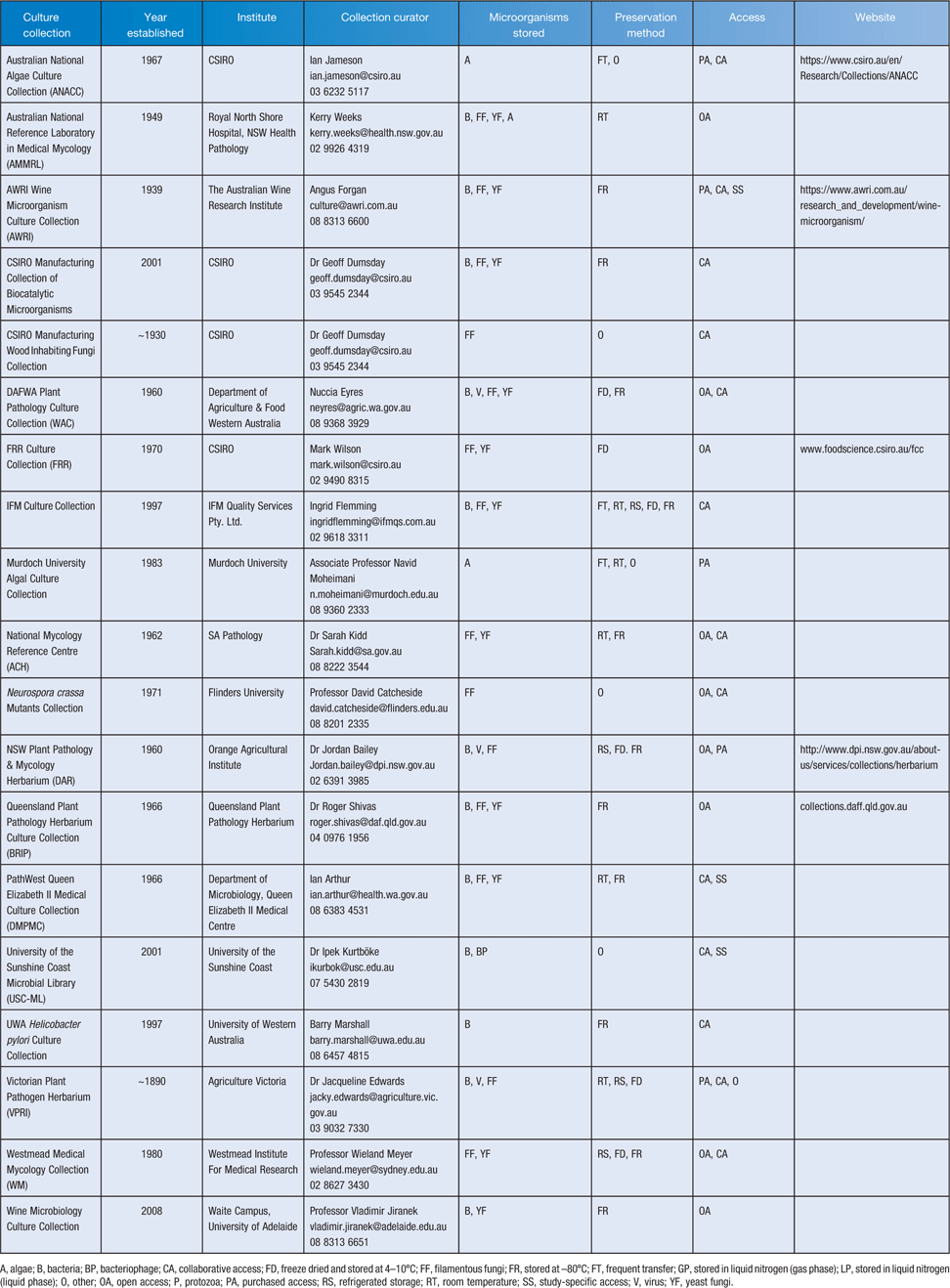Sustainable use and preservation of biological resources
İpek Kurtböke , Wieland Meyer and Lindsay SlyMicrobiology Australia 40(3) 100-102 https://doi.org/10.1071/MA19027
Published: 23 September 2019
Microorganisms, microbially derived biotechnological applications and as causative agents of human, animal and plant disease are becoming increasingly significant in national economies. However, there remains a significant information gap on their species, ecological and genetic diversity1,2. Despite the recognition of their commercial value still little is known about their functional roles in sustaining global ‘life support systems’, such as in agriculture, forest, coastal and freshwater ecosystems as well as their detrimental roles in the environment. As a result, sustainable use, preservation of microbial resources and effective strategies to combat infections are of immense importance to mankind. Culture collections are thus the cornerstones of biotechnology, sustainable futures and infection control.
Many traditional culture collections (CCs) are now transitioning to operate as Biological Resource Centres since the Organisation for Economic Co-operation and Development (OECD) Task Force in 1999 developed the concept and guidelines for the BRCs (http://www.oecd.org/sti/emerging-tech/biologicalresourcecentres.htm). The BRCs play a crucial role in the preservation and provision of biological resources, research and development, conservation of biodiversity, and as repositories for the protection of intellectual property and resources for public information and policy formulation1. Meanwhile, The UN-Convention on Biological Diversity (CBD) was the first agreement to address all aspects of biological diversity: species, ecosystems and genetic resources. It marks the first time that genetic diversity is specifically covered in a binding global treaty (https://www.cbd.int/convention/). The subsequent Nagoya Protocol of the CBD ensures fair and equitable sharing of the benefits arising from the utilisation of genetic resources, including appropriate access to genetic resources and appropriate transfer of relevant technologies (https://www.cbd.int/abs/).
The need to efficiently capture, store, process and analyse large scale information related to the biological resources has also increased due to the advances in molecular biology. As a result, an Ad Hoc Technical Expert Group (AHTEG) on Digital Sequence Information on Genetic Resources was established at the CBD, followed by the actions to clarify terminology and concepts, and to assess the extent and the terms and conditions of the use of digital sequence information of genetic resources in the context of the Nagoya Protocol (https://www.cbd.int/abs/dsi-gr/2017-2018/default.shtml).
The value of any BRC is directly linked to the diversity and quality of the cultures held and the extent and quality of the associated data with the preserved material. In addition, BRCs are the bodies that the public and the policy-makers can call on for objective help in developing regulations and guidelines for the safe and ethical use of biological resources while ensuring compliance with the three key objectives of the CBD. The World Federation for Culture Collections (WFCC; http://www.wfcc.info/) is the largest independent global organisation that represents microbial culture collections concerned with the collection, authentication, maintenance and distribution of cultures of microorganisms and cultured cells. The Federation has developed synergistic capacity with leading organisations (e.g. CBD, GBIF, WIPO, ISO, ECCO) and contributes toward the increase of knowledge on microbial diversity and in turn facilitates the strengthening of the roles of microbial culture collections as tools for research in biodiversity and biosystematics.
In light of the above developments, this special issue of Microbiology Australia is dedicated to the sustainable use and preservation of microbial resources. Beatriz Gómez-Castro and Regina Kipper from the CBD provide an overview of the Nagoya Protocol on Access and Benefit-Sharing, followed by two examples from Germany and Brazil. Manuela da Silva from Brazil contributes with a view from a non-Nagoya Protocol country, whereas Andrey Yurkov, Hilke Marie Püschner and Amber Hartman Scholz from the DSMZ, Germany, inform us about the European Union’s first Registered Collection under the Nagoya Protocol. Tim Fitzgerald provides expert information on the biological deposits for patenting purposes under the Budapest Treaty. David Smith and Matthew Ryan visit the International Postal, Quarantine and Safety regulations. Juncai Ma, Linhuan Wu and İpek Kurtböke provide an update on the 2019 status of the World Data Centre for Microorganisms (WDCM) Global Catalogue of Microorganisms. William B Whitman, Hans-Peter Klenk, David R Arahal, Rosa Aznar, George Garrity, Michael Pester, and Philip Hugenholtz provide information on their collaborative initiative entitled Genomic Encyclopedia of Bacteria and Archaea (GEBA) VI: learning from type strains. Wieland Meyer, Ian Arthur, David Ellis, Alex Kan, Sarah Kidd, Krystina Maszewska and Kerry Weeks provide an overview of the major medical mycology culture collections in Australia. Roger Shivas, Dean Beasley, Kaylene Bransgrove, Yu Pei Tan and Geoff Bulow inform us on Biodiscovery and the Queensland Plant Pathology Herbarium. Lynda Wright provides information on the Australian Biobanks for serum and cells of human and animals. Lindsay Sly reviews historical aspects of Australian culture collections of microorganisms and explores new roles and opportunities for a network of Australian Collections of Microorganisms in the microbiome era.
The Australian Microbial Resources Research Network (AMRRN) was a nationwide initiative with the aim of developing a world class research network to discover and exploit Australian microbial resources and to make these resources and associated information available for applications in science, research, industry and education. In this special issue, we the guest editors, revisit the concept and call for a renewed nationwide effort by the Council of Heads of Australian Collections of Microorganisms (CHACM) to take the AMRRN concept further to fulfilment (see article by Sly), and to realise Skerman’s WDCM vision of fully cataloguing microbial collections and making this information freely accessible. A list of major currently active microbial collections in Australia is provided in Table 1.

|
References
[1] Kurtböke, D.İ. (Ed.) (2017) Microbial resources: from functional existence in nature to applications. Elsevier, Academic Press.[2] Kurtböke, D.İ. and Swings, J. (Eds.) (2004) Microbial Genetic Resources and Biodiscovery. Queensland Complete Printing Services, Australia.


